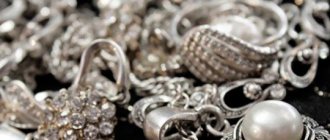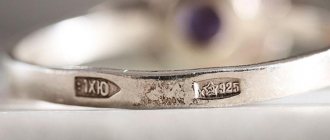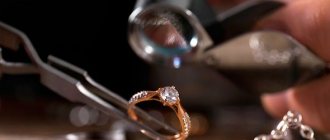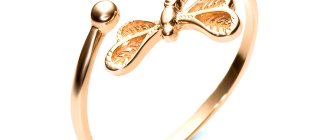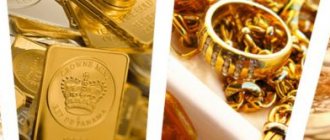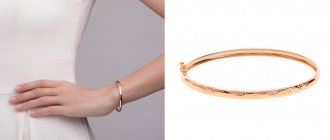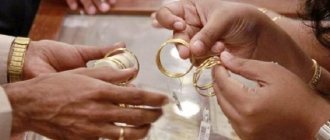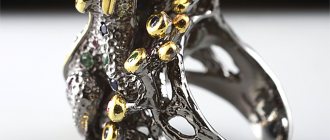The minting of Russian money from silver began around the middle of the 14th century with imitation of coins that came from the Golden Horde and other eastern lands. The manufacturing process at the mints was strictly controlled. When the princely lands gathered into a single Russian state, control over the issue increased even more. The purity of the metal, for example, for the coins of Ivan the Terrible ranged from 970 to 990. Any decrease in it was severely and mercilessly punished. Therefore, domestic silver “scales” escaped the fate of many coins of European territories, whose rulers, in difficult times, significantly diluted precious metals with impurities. However, attempts to mint from low-grade silver were made in Russia at the state level back in ancient times.
Low-grade silver in 18th-century coins
Having significantly eased the treasury's costs by producing small coins from copper, Peter I adhered to maintaining a high standard when minting silver. For example, a half-ruble of 1707 has a standard of 833, and a ten-kopeck piece of 1707 has a standard of 802, which cannot be called low either.
However, some intermediate option is being sought that would allow the production of the middle group of denominations from silver and at the same time save this metal, which was scarce for that time. In 1713, the first silver penny appeared, replacing the exotic denomination “ten money” (weight - 1.40 g, silver - 1.12 g, diameter - 15 mm). However, for the latter, 802nd standard silver was used, while in the nickel the standard is reduced to 396th. But the coin looks more representative (total weight - 2.83 g with a diameter of 20 or 21 mm). Please note that the date is already indicated in Arabic numerals, and the denomination, in addition to the words, is indicated for the illiterate by five lines. Next year, instead of lines, five dots will be minted.
A new type of silver penny is minted using the same principle. It in no way resembles the small penny “flakes” (0.28 g) that are still being produced. Here the total weight of the coin is 0.6 grams with a diameter of 13 mm, but there is only 0.24 grams of pure metal in it. Apparently, the experiment was considered unsuccessful, since the minting of such kopecks and nickels was carried out for two years, and then stopped. There is also an issue of a penny from 1718, dated not with numbers, but with Old Church Slavonic letters. The 1723 dime was also minted in a reduced 728 standard, which would soon become the standard for silver coins.
This period begins under Catherine I, when rubles and half rubles begin to be minted in such purity of metal. In 1726, the hryvnia appeared, using 438-carat silver. The St. Petersburg Mint continues to issue with the date “1727”, but in extremely small quantities, after which hryvnias are not issued at all. It is quite possible that they planned to make this denomination in copper, since a test copy of the so-called “Menshikovsky” ten-kopeck piece made in copper has survived to this day.
During the reign of Peter II, silver of the 728th standard continued to be used for the minting of rubles and half-rubles, which under Anna Ioannovna increased to the 802nd (including the kryvennik and half-fifty, which supplemented the coin series). It was only under Ivan Antonovich that the purity of the metal was again divided: the ten-kopeck piece had a 750th purity, and rubles and half kopecks had a purity of 802. It’s even more interesting to track the parameters by which Elizaveta Petrovna’s silver was minted. Silver nickels 1755-1761. (type “Eagle in the Clouds”) and rubles retain their previous value, but ten-kopeck coins of 1742-1757. metal of 750 standard is obtained (samples of 15 and 20 kopecks, which are not widespread, are minted in it). This standard was established by Peter III (under whom 10 kopecks moved into the copper series) and supported by Catherine II for all silver denominations, including the 15 and 20 kopecks that did appear in circulation. Only Paul I decides to increase the purity of the metal to the 868th standard for all denominations, starting from 5 kopecks and ending with the ruble. To summarize, we note that the 18th century was characterized by high metal purity, which was strictly adhered to by all rulers, starting with Peter II.
Delivery process
When going to a credit institution, the client needs to decide on the method of depositing the precious metal. After all, the actions of pawnshop workers will depend on the purpose for which the client brought the valuables:
- for sale;
- as collateral for a loan.
In the first option, manipulations of weighing, measuring and evaluating silver products are carried out in the presence of the client. Completion takes 20–25 minutes. Next, a purchase and sale agreement is drawn up. Each product and scrap sold is indicated, the weight of each of them accurate to hundredths of a gram, the price per gram and amount, as well as the date of the transaction. The agreement is drawn up in two copies.
Silver jewelry and products in any condition, of any standard or without it, as well as technical silver and scrap are accepted for sale. The selling price is usually slightly higher than the deposit price. After reading and signing the contract, the client is given 1 copy of it and is paid the amount specified in it. After this, the valuables become the property of the establishment.
If the precious metal is handed over to a pawnshop as collateral for a loan, then the registration is carried out as follows:
- Values are weighed in the presence of the client.
- The sample of the precious metal is specified.
- They evaluate products.
- If the client is satisfied with the estimated value, then a loan agreement or collateral agreement is drawn up. They indicate the type of product, estimated value, loan amount, date of receipt and return, as well as interest for the use of borrowed funds. A separate clause specifies possible penalties for violating the terms of the contract.
- The loan agreement is drawn up in 2 copies: one is given to the borrower, the other remains in the institution.
- After reading and signing the agreement, the client receives the entire loan amount in cash.
- The collateral is placed in the pawnshop's storage for the entire duration of the agreement.
- As soon as the client decides to return the loan and pays the accrued interest on it, the jewelry will be returned to him.
It happens that the client is not able to repay the loan at the end of the period specified in the contract. Then the pawnshop does not have the right to sell the valuables it holds as collateral within one month.
Sample of silver coins of Alexander I and Nicholas I
Throughout the reign of Alexander I, rubles, half-fifty rubles and half-rubles retained the standard set by his father. But the middle group of denominations (5 - 20 kopecks), which appeared in 1810, acquires 750-carat metal. It must be remembered that in Russia at that time there was a double currency circulation. A large number of banknotes were exchanged for copper money, but not for silver. But taxes were historically collected in silver money. Therefore, the ruble in silver was valued several times more than the ruble in copper. After the war with Napoleon, Russia was flooded with counterfeit banknotes, which is why a ruble in paper money at that time cost only 20 copper kopecks. Under such conditions, experiments with lowering the silver standard could lead to the collapse of an already unstable financial system.
Nicholas I, having ascended the throne, returned all denominations in silver to 868-carat metal. Subsequently, a single and sufficiently high standard of coins became one of the conditions for the successful implementation of monetary reform by Finance Minister Kankrin, which placed silver at the head of the financial system, which provided credit notes introduced instead of banknotes. Therefore, it can be noted that the first half of the 19th century excluded the presence of low-grade silver coins in circulation.
Which one can be taken?
To prevent a trip to a pawnshop from being in vain, it is advisable to find out in advance where they sell silver. Some collateral offices are reluctant to work with this precious metal due to its low cost. Of course, if you don’t donate 925 silver, the price of which depends on the alloy additives included in its composition. For example, an alloy of silver and cadmium is valued much more than gold. But it is not profitable to hand over silver-plated items, since they are accepted at the same scrap price.
The silver the pawn shop is interested in is presented by:
- jewelry;
- cutlery;
- household utensils (trays, coffee pots, sugar bowls, etc.);
- accessories (cigarette cases, lighters, cufflinks);
- antiques;
- silver scrap (broken and broken items, steamed jewelry);
- technical silver (wires, wires, silver elements extracted from device parts).
Not all types of precious metal are accepted at such lending institutions. Some offices only accept scrap silver.
Reducing the standard of silver using the example of coins of Alexander II
The Crimean War greatly undermined the economy and monetary system of Russia, negating all the successes of the short-lived era of silver monometallism. Alexander II, who received the country in a rather difficult period, was forced to begin transformations, the crown of which would be the monetary reform planned for 1862. Due to the fact that once again the accumulated mass of unsecured paper money required for exchange a large amount of precious metals, which the treasury did not possess, the reform did not take place (it was only possible to carry it out under Nicholas II). However, using the example of the silver coins of Alexander II, we can trace a change in the composition of the metal, not for the better. Until 1860 inclusive, silver of 868 standard was used for coinage.
Next comes a period of decline. But large denominations (ruble, half and 25 kopecks) remain inviolable. The changes will affect that part of the coin series that contains coins in denominations from five to twenty kopecks. In parallel with the old-style money, new coins are being minted, using the 750th standard of metal. But more important was the decrease in silver content. Let's look at the comparative characteristics of new and old coins from 1860:
- 5 kopecks (old): weight - 1.04 g, silver - 0.90272 g, diameter - 15.1 mm;
- 5 kopecks (new): weight - 1.02 g, silver - 0.765 g, diameter - 15.1 mm;
- 10 kopecks (old): weight - 2.07 g, silver - 1.79676 g, diameter - 17.65 mm;
- 10 kopecks (new): weight - 2.04 g, silver - 1.53 g, diameter - 17.6 mm;
- 15 kopecks (old): this denomination was not minted after Catherine II until Alexander II;
- 15 kopecks (new): weight - 3.06 g, silver - 2.295 g, diameter - 19.8 mm;
- 20 kopecks (old): weight - 4.14 g, silver - 3.59352 g, diameter - 22mm;
- 20 kopecks (new): weight - 4.08 g, silver - 3.06 g, diameter - 22mm;
As you can see, the new and old coins did not differ in appearance (diameter, design), but the weight and silver content decreased somewhat. And new transformations were already looming ahead.
Royal silver coins of 500 standard (1867-1917)
The year 1867 became a landmark year, starting from which coins in denominations from five to twenty kopecks began to be minted from low-grade silver (500 standard).
- 5 kopecks: weight - 0.9 g, silver - 0.45 g, diameter - 15.1 mm;
- 10 kopecks: weight - 1.8 g, silver - 0.9 g, diameter - 17.5 mm;
- 15 kopecks: weight - 2.7 g, silver - 1.35 g, diameter - 19.7 mm;
- 20 kopecks: weight - 3.6 g, silver - 1.8 g, diameter - 22mm;
Among numismatists, these coins are called “billon”. This definition came to us from the French language. Here it must be pointed out that billon coins are those coins whose purchasing power exceeds the value of the metal they contain. That is, the cost of silver in royal two-kryvnia is now lower than the declared denomination. Figuratively speaking, for two kopecks one could purchase more silver by weight than was spent on its minting. However, in collecting circles, a "billon" often refers to any silver coin of .500 fineness or lower. The above denominations were minted in this metal purity both under Alexander III and Nicholas II.
What products are interesting to pawn shops?
Once you have decided on the pawnshop where you want to donate your silver, familiarize yourself with the products that it accepts. For each network, the list of jewelry and other items made from this metal varies.
Almost all pawn shops are interested in the following silver items:
1. Decorations. This category includes rings, bracelets, chains, watches, both made of pure silver and inlaid with stones. 2. Dishes. Everything is interesting – from silver tea spoons to trays and place settings. The greater the mass of the dishes, the greater the amount you can count on. 3. Interior elements. This group includes various snuff boxes and figurines. 4. Coins and bank silver (bullions). 5. Antiques, antiques. 6. Technical silver. This includes wires made of this material, as well as parts that were removed from devices. 7. Crowbar. The lowest pay is given to broken silver items, mismatched earrings, torn watch straps and other unusable items.
You must understand that a pawnshop is not a store that buys your things. You give silver items as collateral with a subsequent right of redemption after returning the amount with interest.
Rare coins of the Russian Empire made of low standard silver
The rarity of a coin is influenced by several factors. First, the total number of coins of a specific denomination with a specific date. Secondly, when mintzmeisters change, coins with the same date have different letters on the obverse. And one of the options can be minted in small quantities. Thirdly, the number of coins with “Proof” quality (mirror field and matte relief) is derogatingly small in comparison with similar examples of regular coinage. And in certain years, silver could be minted exclusively in “Proof”.
Among the rare five-kopeck coins, one can highlight 5 kopecks 1878 SPB-HI (Alexander II), 5 kopecks 1883 SPB-DS and 5 kopecks 1883 SPB-AG (Alexander III), 5 kopecks 1901 SPB-AR (Nicholas II). Only in “Proof” quality, 5 kopecks of 1904 SPB-AR and 5 kopecks of 1913 SPB-EB were minted in scanty quantities. The last time a silver five-kopeck piece was minted was with the date “1915.”
A rare ten-kopeck coin issued by Alexander II was 10 kopecks from 1878 SPB-NI . During the reign of Nicholas II, among the rarities were 10 kopecks from 1895 SPB-AG , as well as 10 kopecks from 1913 SPB-EB, known only as “Proof”.
Among the five-altyn coins of the era of Alexander III, 15 kopecks from 1882 SPB-DS . During the reign of Nicholas II, 15 kopecks of 1896 SPB-AG and 15 kopecks of 1899 SPB-EB . The year 1912 is significant in that 15 kopecks with the letters “VS” are rare in ordinary quality. But as a “Proof” rarity, a fifteen-kopeck coin from 1913 with the designation of the mintsmeister “EB” is listed.
A few words about 10 and 15 kopecks without letters on the obverse . Despite the impressive circulations, after the outbreak of the First World War, Russia began to experience a huge shortage of small change coins. Stamp money is even being introduced into use. Therefore, the order for the minting of an all-Russian coin with the date “1916” goes to the Osaka Mint (Japan). These coins are distinguished by the absence of the mintzmeister's initials. They are not rare. Their occurrence is approximately the same as that of their counterparts with the letters “VS” (the initials of Viktor Smirnov). I wonder if Japanese coins would still have the abbreviation “SPB” on the reverse? But since 1915, due to the renaming of St. Petersburg to Petrograd, these three letters disappear from the reverse of all Russian small change coins.
For two-kopeck coins, we highlight 20 kopecks of 1867 SPB-NF and 20 kopecks of 1878 SPB-HI (Alexander II), as well as again 1912, when 20 kopecks “VS” are rare in regular coinage, and 1913, where 20 kopecks “EB” known only in Proof. In this capacity, a similar story turned out with 20 kopecks of 1901 SPB-AR. 10, 15 and 20 kopecks manage to come out in small editions even in the year of the collapse of the empire. You can read more about the royal coins of 1917 here.
Low-grade silver of the RSFSR and USSR
Already in 1921, the young Soviet state was thinking about minting its own coin. So far, the only thing on the agenda is silver, which they decided to mint according to royal standards. Accordingly, denominations of 10, 15 and 20 kopecks begin to be minted from the same 500-grade precious metal, while the ruble and 50 kopecks retain high-grade silver. On the obverse is the coat of arms of the RSFSR. The reverse from the old days retains a wreath of laurel and oak branches, but in the upper part of the coin field there is a five-pointed star. The release continues for three years in a row. Only coins with the date “1921” are rare. However, these copies came into circulation already under the USSR after the stabilization monetary reform was carried out.
The formation of the Soviet Union was the reason for the change in design. The obverse now bears the State Emblem of the USSR. The role of a propaganda poster during this period is played by the ruble and fifty dollars. The design of small silver, on the contrary, is simplified. The parameters of the coins remain the same (including the fineness of the metal). In this form, 10, 15 and 20 kopecks are issued until the end of the decade. The question arises about the inappropriateness of using precious metal to issue coins. And, starting in 1931, cupronickel replaced silver. But with the date "1931" there are also rare and very valuable silver coins. This article tells more about this release.
Series “Outstanding Personalities of Russia”
Further, silver as a coin metal appears only in preparation for the 1980 Olympics, when sets with Olympic scenes are minted from 900-carat silver. Toward the end of its existence, the USSR began to mint various collectible coins from high-grade precious metals. It would seem that the era of low-grade silver is over forever. But in the mid-90s, the Central Bank of the Russian Federation began issuing a series of two-ruble coins “Outstanding Personalities of Russia.” Unexpectedly, the 500th sample of silver is chosen for minting. Why are these coins not called “billon”? Because the cost of silver in them is much higher than the declared face value. In this format (quarter ounce of pure silver) the series was published in 1995-1997. Since 1998, instead of the LMD sign, the SPMD emblem appears on collectible coins (everyday mintages acquired it a little earlier in preparation for the upcoming monetary reform), the fineness of the metal of this series increases to 925 (sterling silver), and its content becomes equal to half an ounce ( 15.55 grams).
Let’s finish the article with one of the coins of “young Russia”, minted for the half-century anniversary of the Victory. For the extensive coin program, a common version of the obverse was used (an image of the Spasskaya Tower of the Moscow Kremlin and the partially overlapping dome of the Senate Palace with the waving flag of Russia), but a small part of the circulation of the “Flags at the Kremlin Wall” coin received an obverse from a representative of “Outstanding Personalities.” “Pereputka” rarely appears at auctions and is expensive. But it, like the usual version of the two-ruble coin, is minted from 500-carat silver.
The cost of silver in a pawn shop
The price of silver in a pawn shop per gram is determined by stock quotes, the jewelry value of the product and its fineness.
An important factor in determining the price is the artistic value of the item. If this is an antique item, the conditions for its delivery are somewhat different from the standard ones. In this case, you should contact a specialized pawnshop. The most popular and expensive is 999 silver. But others are also quoted: 800, 916, 910, 925.
The common 925 is found quite often. You will receive more accurate information about how much it costs to hand over 925 silver to a pawnshop at a specific institution for the purchase and sale of valuable items and goods. On average, prices are at approximately the same level, so you need to start from 36 rubles. for 1 gram of silver.

